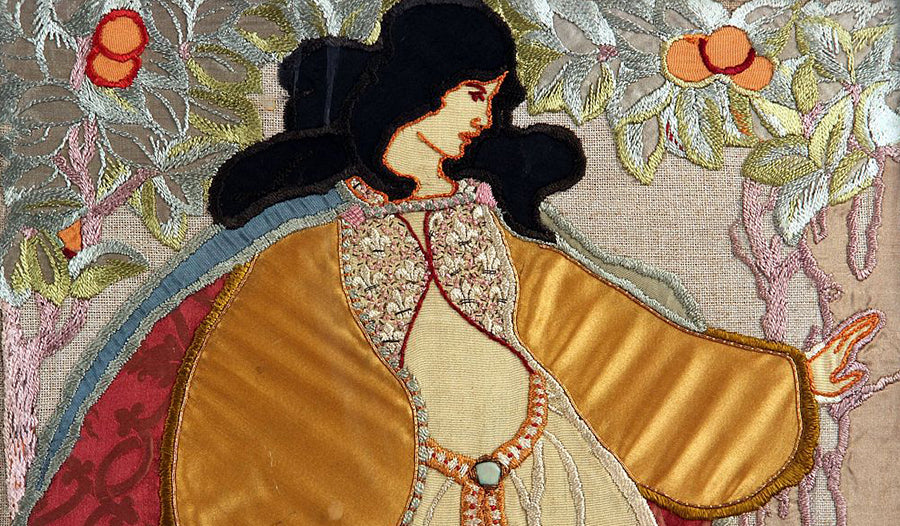
GIRL POWER
 Image: Example of late 19th to early 20th century needlework embroidery, in the style of the Glasgow School
Image: Example of late 19th to early 20th century needlework embroidery, in the style of the Glasgow School
The first Selvedge Literary Festival will examine the varied literature forms that reveal and document the history and culture of cloth. In anticipation of our event, we share an extract of Clare Hunter's book, Threads of Life (Sceptre, 2019), a globe-spanning history of sewing, embroidery, and the people who have used a needle and thread to make their voices heard:
Girl Power: Glasgow School of Art embroidery
It was the staff and students of the Department of Needlework at Glasgow School of Art, who, at the end of the nineteenth century and the beginning of the twentieth, scooped embroidery from its undervalued past and set it firmly in the future as a stand alone art form. They didn’t use their needlework to register status or to honour tradition. Instead they experimented with its potential as art. They explored its sensuality, the visual impact of its techniques and the possibilities of combining fabrics, colours and textures to create an unexpected harmony.

Image: Cushion cover, Jessie Newbery, 1864 -1948, 12 x 60 x 50 cm, embroidered linen with silks, linen applique.
The female artists at Glasgow School of Art were the first women in Scotland to encroach on its hitherto masculine artistic stronghold. Dubbed the ‘Glasgow Girls’ in the 1960s, (not with derogatory implications, but to place them on par with the Glasgow Boys, a collective of male painters who were their peers) these women were pioneers. They were educated, middle-class and independent. Women who had no financial need to storm the barricades of a defensive male art elite and no need to risk ridicule as women artists in a precarious, prejudiced world. But they were on a mission to demonstrate that their interpretations of crafts such as book-binding, metalwork, enamelling as well as needlework were as valid artistic expressions as paint, as worthy of judgement alongside its male counterparts of sculpture and painting. These women established their own studios, exhibited internationally, submitted work for competitions, gave lectures, wrote articles, taught other women, enlightened men and claimed their place in the art world.
The embroidery students were determined to have needlework accepted as a distinct art form, worthy of critical attention alongside painting and sculpture and removed from its limiting association with a constructed view of the ‘feminine’. By 1902 the department was rewarded with government approval and the embroidery course at Glasgow School of Art was certificated with its own diploma. Needlework became the most important feature of the school’s Department of Fine Arts.
 Image: Sleeping Beauty, Ann MacBeth, 1875-1948, 48 x 206 cm, beige silk with silk applique and embroidered with gold metal and silk threads.
Image: Sleeping Beauty, Ann MacBeth, 1875-1948, 48 x 206 cm, beige silk with silk applique and embroidered with gold metal and silk threads.
Women artists created a climate of exploration at Glasgow School of Arts, and a tradition of innovative needlework. While they didn’t succeed in completely eradicating the gender-based discrimination needlework faced, they were active agents in demonstrating how sewing could be central to an artistic movement. They left a legacy, the legacy of textile art, a term coined later, which others would embrace, experiment with and explore, investigating the limitless possibilities of needlework’s materials and techniques to express their professional art.
Excerpt from Threads of Life by Clare Hunter.
Clare Hunter has been a banner-maker, community textile artist and textile curator for over twenty years. She established the community enterprise NeedleWorks in Glasgow and her first book Threads of Life won the Saltire First Book Award, was a Waterstones Scottish Book of the Month and a Radio 4 Book of the Week.

We're delighted that Clare will be taking part in the first Selvedge Literary Festival, a celebration of the varied literature forms that reveal and document the history and culture of cloth.
Clare will explore the material world of Mary, Queen of Scots and how she and other female rulers in the sixteenth century exploited textiles to assert their presence and power on the European political stage. Through displaying, gifting, wearing and creating textiles redolent with meaning, these women proclaimed and preserved their worth in the face of adversity. When women's embroidery was synonymous with women's writing, they used it to script their own testimonies and conserve their stories.
Book your tickets and find out more about the Selvedge Literary Festival here:

